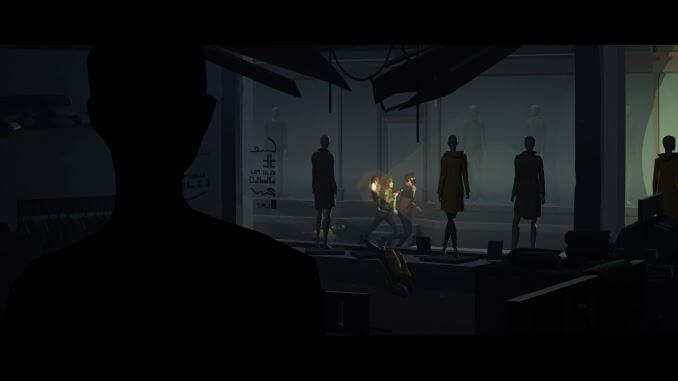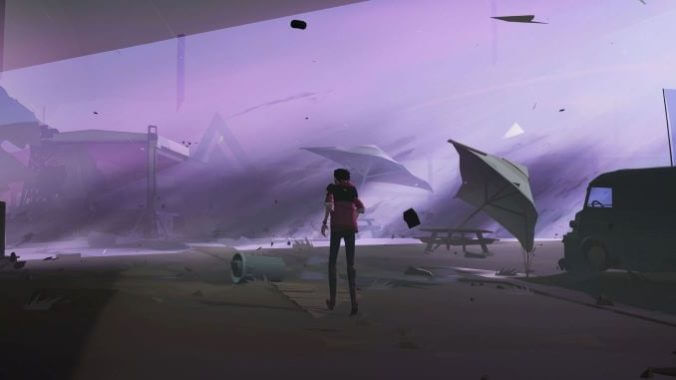Somerville is ridiculously beautiful. Take the opening, for example: A family wakes from their collective couch nap to an unprecedented and unprompted alien invasion. Suddenly, War of the Worlds is playing it out in the heavens above them, with its refuse crashing down on their unsuspecting lives. Alien obelisks jut from the clouds, garish neon pink lights shoot out, and spikes pierce through their car and home as they simply try to account for the impossible and escape with their lives and family intact. It’s a sequence that genuinely captivated me, even though I knew it was coming, because Jumpship’s commitment to realizing the sights and sounds of an invasion is unrivaled. This remained true even when my character, who seemed to die in the opening, came back to life and explored the fallout of the war. Soonanother truth came to light as I stumbled across the dilapidated countryside, though, and it was that Somerville has a compelling vision but suffers from middling execution.
Somerville tries to do more, but I don’t know that it succeeds. While I’ll try to ease up on the comparisons, it’s hard not to look at it and see Dino Patti’s (Jumpship’s co-founder) last game, Inside, all over it. They both revel in visual storytelling and succeed at making the dystopic and frightening look starkly gorgeous. They even have sequences that are not entirely unalike, but Somerville strikes out on its own in some key ways, chief among them being that it plays in 3D rather than 2D, leaning further into the dioramic aesthetic Inside so thoroughly realized. Though the transition feels like the natural evolution of things, Somerville couldn’t have a harder time convincing me it was the best call.
The thing is that Somerville is kind of obtuse—as obtuse in its storytelling (which I’ll get to in a second) as it is its construction of 3D spaces. Parts of it feel momentous and impactful, while far too many others feel lacking in clarity and punch. There’s a fair bit of the game that feels like you’re meandering, like an extended stay in a mine shaft, and this extends as much to some of the game’s puzzles as it does exploration and movement. One early sequence with a bucket stands out to me as one such puzzle that would have benefited from being rendered in a more tightly constructed space, but instead feels so loose it constantly gets in its own way because of disruptive elements beyond my control and geography.

This looseness also means that it sometimes feels like a chore to move through and engage with Somerville’s post-apocalypse. In 3D, depth perception is a vital way to communicate information, and sometimes Somerville seems to forget that. I felt like I constantly needed to fidget my character to get them to properly align with something they needed to interact with or pass through, but their uneven movement turned transitioning from one scene to another into a chore. This undermines Somerville’s serviceable puzzle mechanics, which involve using alien abilities to deconstruct or harden material around you. You can use these to create paths through obstacles, and the puzzles smartly grow in complexity without straying too far from their original intent for the sake of difficulty. They’re enjoyable, if fairly light, and are only made better by the rarely added pressure of the alien threats that seem to stalk you.
When these aliens do show, the game comes to life. I feel most in tune with the character, whose primary motive is surviving enough to reunite with his scattered family, when I’m narrowly escaping them and their otherworldly technology and mannerisms. It is such a shame then that just as your interactions start picking up in frequency and tension, and these elements begin dovetailing with one another and crescendos into one of my favorite (if still uneven) sequences this year, that you are then jettisoned—as is seemingly tradition with this cadre of games—into a final act that haphazardly abandons the literal in favor of the abstract. It isn’t that Somerville appears to leave behind the hard sci-fi story it spends the entirety of its runtime building to, it is that it does leave behind the distinctly grounded take on this man’s journey back to his wife and son for an ending that feels like an unnecessary abstraction of the story that was front and center the whole time. It simply loses focus as it reaches for something loftier, when I think it could’ve done far more right where it was.
Somerville is not a misfire as much as it is marred by a few crucial missteps. While I did broadly enjoy my time with the game, I wish I felt more attached to or endeared to the utterly beautiful world Jumpship created. Though getting through it was occasionally bumpy, I only wish I’d been able to get more of it once it really got going. And had Somerville maintained its human element front and center, I think I would’ve loved the way the story ended more than I ultimately did. As it stands though, Somerville is a notable debut by Patti’s new studio, it just has some of the wrinkles of one too.
Somerville was developed and published by Jumpship. Our review is based on the PC version. It’s also available on Xbox Series X|S and Xbox One.
Moises Taveras is the assistant games editor for Paste Magazine. He was that one kid who was really excited about Google+ and is still sad about how that turned out.

